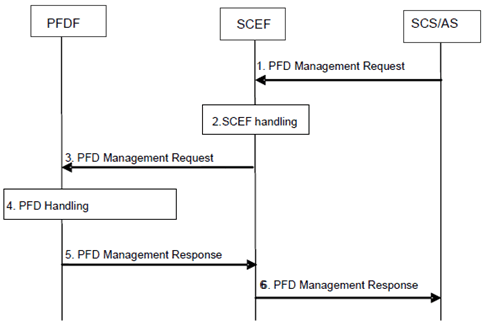Content for TS 23.682 Word version: 19.1.0
1…
4.2
4.3…
4.4…
4.5…
4.5.7…
4.5.14…
4.6…
5…
5.3…
5.5…
5.6…
5.6.2…
5.6.6…
5.7…
5.8…
5.9…
5.13…
5.14…
5.15
5.16
5.17…
5.18
5.19…
A…
C…
5.14 PFD management via SCEF |R14| p. 114
5.14.1 Procedure for PFD management via SCEF p. 114
This procedure is used by the 3rd Party SCS/AS to manage PFDs into the operator network via SCEF. Figure 5.14.1-1 illustrates the procedure.

Step 1.
The 3rd party SCS/AS sends a PFD Management Request (SCS/AS Identifier, external Application Identifier(s) and one or more sets of PFDs and PFD operation for each Application Identifier, Allowed Delay) message to the SCEF. The external Application Identifier(s) should be provided by an 3rd party SCS/AS that is known at the SCEF, so that the 3rd party SCS/AS and the MNO has an SLA in place. PFD operation indicates that the PFD is to be created, updated or removed in the operator's network. The Allowed Delay is an optional parameter. If the Allowed Delay is included, it indicates that the list of PFDs in this request should be provisioned to all the PCEF/TDFs known in the PFDF within the time interval indicated by the Allowed Delay.
Step 2.
Based on operator policies, if the 3rd party SCS/AS is not authorized to perform this request (e.g. if the SLA does not allow it due to the Allowed Delay is too short or other reasons), the SCEF performs step 6 and provides a Cause value appropriately indicating the error. Otherwise, the SCEF translates each external Application Identifier to the corresponding Application Identifier known at the PFDF.
Step 3.
The SCEF sends a PFD Management Request message (Application Identifier(s), one or more sets of PFDs and PFD operation for each Application Identifier, Allowed Delay) to the PFDF.
Step 4.
The PFDF creates, updates or deletes the list of PFDs for each Application Identifier into the PFDF as requested by the respective PFD operation.
Step 5.
The PFDF sends a PFD Management Response (Application Identifier(s), Cause) message to the SCEF to provide the feedback of the handling result for the PFD Management Request.
Step 6.
The SCEF sends a PFD Management Response (Cause) message to the 3rd party SCS/AS to provide the feedback of the handling result for the PFD Management Request.
5.14.2 PFD definition p. 115
PFD (Packet Flow Description) is a set of information enabling the detection of application traffic including:
- PFD id; and
- one or more of the following:
- 3-tuple(s) including protocol, server side IP address and port number;
- the significant parts of the URL to be matched, e.g. host name;
- a Domain name matching criteria and information about applicable protocol(s).